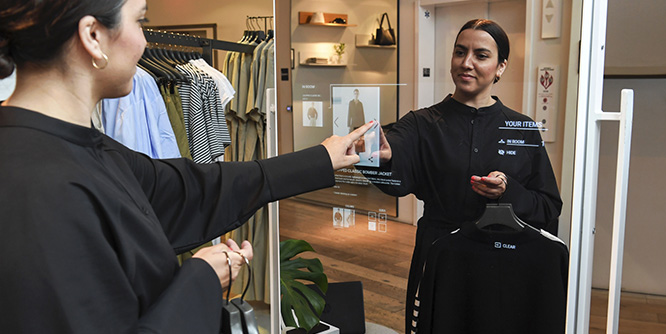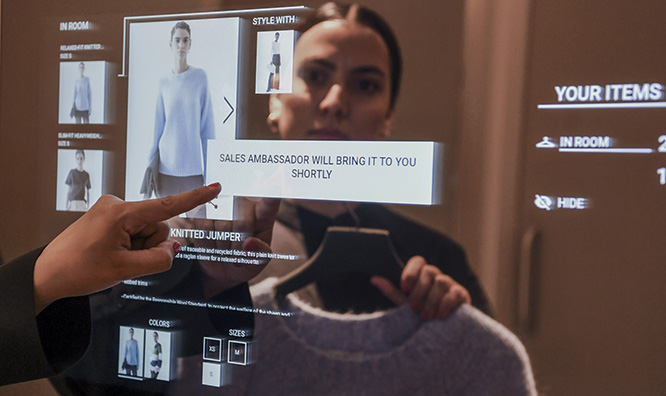
Photo; H&M Group
Is H&M smart to give mirror tech another try?
H&M Group has been testing the use of smart mirrors in fitting rooms and on the sales floor at its COS Beverly Hills store and now plans to extend the technology to more stores this year.
Promised benefits include:
- Personalized product and styling recommendations: When a customer brings an item near the smart mirror, the item appears on-screen along with styling recommendations. The customer can see other sizes and colors and buy directly from the mirror.
- Social sharing: Customers can share a link to an item via the mirror to social media.
- Dressing room assistance: A customer can use the mirror to request an item and a sales advisor will bring the item to their fitting room.
Smart mirror technology, powered by artificial intelligence, is seeing the most attention with fitness brands like Lululemon, Tempo, Tonal. Lululemon-owned Mirror offers the ability to stream live classes and access on-demand content from homes. Some smart mirrors offer skin advice and some bathroom mirrors offer weather and other content.

At retail, designer Rebecca Minkoff caught wide coverage in 2014 for installing dressing room mirrors at her New York City flagship that doubled as touchscreens, allowing customers to browse looks and receive curated suggestions. Her stores closed during the pandemic.
Nordstrom, at around the same time, tested smart mirrors in dressing rooms, while Neiman Marcus tested mirrors at beauty counters that took a 360-degree video of a client, allowing them to see and share their new look from all angles.
Experimentation with smart mirrors continues, particularly for virtual try-ons and skin care advice in beauty retail.
Amazon.com’s recently-launched Amazon Style store mixes mobile phones and touchscreens to elevate the fitting room experience, according to a blog entry. Customers use their app to scan QR codes of items, choose from sizes and colors, then have those items sent to fitting rooms to try on. A touchscreen in the fitting room welcomes the customer. The customer then uses the touchscreen to browse and rate items “to get new picks in real time and request more styles and sizes to be delivered to their fitting room closet in just minutes.”
- H&M Group explores tech-enabled shopping experiences in US stores – H&M Group
- Amazon reimagines in-store shopping with Amazon Style – Amazon.com
- The Magic Of Smart Mirrors: Artificial Intelligence, Augmented Reality And The Internet of Things – Forbes
- Nordstrom tests smart fitting rooms – RetailWire
- Smart Mirrors Reflect New Ways to Shop – IoT integrator
- Amazon says first clothing store will be a fashion and technological revelation – RetailWire
Discussion Questions
DISCUSSION QUESTIONS: Will advances in artificial intelligence, new features or reduced costs eventually make smart mirrors more prevalent on selling floors? Do you see apparel fitting rooms and selling floors, beauty counters or some other in-store experience particularly benefiting from the technology?


Keep testing! This kind of tech enhanced, tech enabled shopping in physical stores is a logical evolutionary step in apparel retail. We know we can’t live with the return rate when we send boxes of product to the customer’s home. So let’s try expanding the range of choices offered to the shopper in a setting where both styling and fit are immediately solvable. And then let’s see what happens to units per transaction and average basket size.
Technology has improved and customers are more comfortable using it, but retailers still must let customer experience lead their tech implementations to achieve successful outcomes. Too many tech decisions are made to reduce labor costs or gather more data rather than aligning the technology to how people actually shop – which is the leading reason tech rollouts have failed in the past.
I think they make a lot of sense and the tech is ready. (Full disclosure: the provider of this tech to COS is my client).
I think retailers have GOT to get shoppers back into stores, and into fitting rooms, if for no other reason than it’s the only way to reduce returns and improve profitability.
Getting customers back into stores and engaging with them in an exciting way is going to impact the PNL incredibly. Reducing returns and increasing gross margins is exactly what retailers need to be thinking about right now. Next step – rethink the line plan and merchandising strategy, increase speed to market and reduce overbuying. Retailers will get there – they just need to take the leap already!
So many great discussion points and Paula – I love that you have a front row seat!
The key to tech in stores always comes down to whether or not the experience is augmented by it. If these mirrors could tell the shopper what additional sizes and colors are available in the store, plus what sizes and colors are at other nearby stores, that would be incredibly helpful. This is a big opportunity to assist customers in determining where inventory levels stand and to help them get items as urgently and conveniently as they likely want, given that they’re in a brick and mortar space. Similarly, if the social media function allowed the customer to send the images from the mirror to a friend or family member via text, versus posting to a story, they could make informed shopping decisions based on the real stakeholders that matter when buying.
This will only work once the industry sees consumer adoption, which has not fully happened. I like the call for size service, but I am not sure the smart mirrors replace anything that mobile apps cannot do. I see the true value in capturing data and sharing the data with the brands. Evaluating fit, number of sizes from the same item tried on, what is being paired with the item, etc. That is first person data that could be very valuable.
I believe the earlier forays into smart mirror technology were just before their time. Today people are more expensive than ever and this technology saves money and increases sales. If you can reduce labor responsibilities by executing functions, activities, tasks and steps while increasing customer satisfaction by offering assistance curating looks and retrieving different colors and sizes, it is a win for the customer, the retailer and the associate.
Smart mirrors will absolutely transform the dressing room experience and, when the technology is ready, I’ll predict wide adoption.
One thing is sure. The technology of mirrors we see today will be the Model T compared to where they will be in the future. The narrative and my BrainTrust colleagues have indicated how these mirrors can help a customer. But those thoughts are just the beginning. The technology is in its infancy. The improvements may surpass our imagination today.
Artificial Intelligence is the future and it is impacting every industry, retailers have already started to adopt AI to provide a better customer experience. The concept of “smart mirrors” will definitely attract customers who look for convenience and friction-free services. As these mirrors will allow customers to virtually try on different styles of clothing and get personalized recommendations. Customers can also seek skin and beauty advice. A brand introducing such devices must ascertain that their functionality is intuitive and easy to use. Many brands are trying to be more inclusive with such technology and to augment the user experience these new innovations are the key. Smart mirrors are possibly still in the pilot phase but if implemented correctly they can be a success.